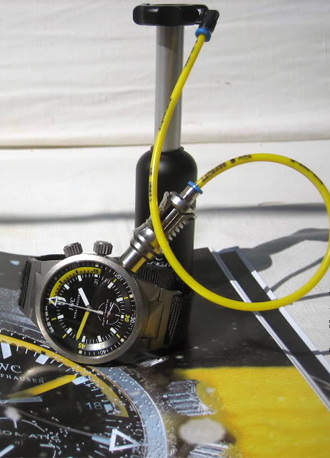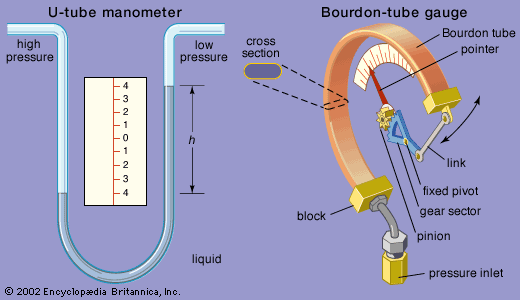|
IWC was the first brand that created the underwater watches whose depth gauge was inside the case itself. Deep One watches for many parameters can be called revolutionary: they had an internal rotating bezel for monitoring dive time and as much as two hands to count the depth (one showing the maximum depth and the second - current).
Developer of the company IWC Heybring Richard came up with these watches relaxing on board the boat for scuba divers. He asked experts how they imagine the perfect device that allows you to determine the time at great depths. The appearance of hours Aquatimer Deep One in 1999 created a sensation. Outwardly it was a device of the space age, and functional - a genuine wrist supercomputer created solely by technologies of watchmaking. these watches relaxing on board the boat for scuba divers. He asked experts how they imagine the perfect device that allows you to determine the time at great depths. The appearance of hours Aquatimer Deep One in 1999 created a sensation. Outwardly it was a device of the space age, and functional - a genuine wrist supercomputer created solely by technologies of watchmaking.
True, it was necessary to limit the depth of the dive watch to 100 meters in order not to spoil the depth-sensing mechanism, as the space allotted to the tube inside is limited, so that the tube can only straighten up to certain limits. The instructions to the clock says:
"To prevent damage to a depth of about 50 m of a device for mechanical protection depth gauge, and with further immersion depth of the device is not registering."
To watch attached pump, readily add to the valve through which water enters. To a depth gauge started, before every dive in Bourdon tube pumped air. To determine the elapsed time before the inner rim of the dip is turned so that the minute hand coincides with the zero mark of the timeline. Externally, a depth gauge is constructed in the same way as the split-chronograph: the dial has two overlapping arrows. When submerged, they begin to move together, starting at a depth along the perimeter of the dial scale. When the diver reaches the maximum depth, the yellow arrow freezes in place and remains in this position even after returning to the surface. To reinstall the depth gauge, simply click on the same head, by which the rim rotates with the scale.
The creators have found an interesting solution to the problem of having to account height. The atmospheric pressure at sea level is stronger than at the height, which affects the behavior of the Bourdon tube. To adjust the depth gauge with vertical drop, it reset the hand with the bottom right of the head to "4 hours", which is integrated valve Bourdon tube.
Since the company's specialty - the mechanical wrist watches, the device also had to be one hundred percent mechanical. In creating the depth-old helped the developers tried and tested method of measurement of pressure in steam engines still - Bourdon tube. This instrument is named after its inventor, French scientist and watchmaker Eugène Bourdon. This unit, established in 1849, allows pressure measurements up to 700 000 kPa. Bourdon tube arranged quite easily. The main element of it - sealed at one end curved semicircular tube that communicates with the pressure source. When the pressure increases, the tube is straightened, and at lower pressure, in contrast, is bent. Tube by means of the transmission system is connected with an arrow, and change its shape causes the arrow to the effect: it indicates the pressure on the scale. By the way, some parts borrowed from the transmission of watchmaking - for example, a comb, which is used in the device of perpetual calendar with retrograde hours and arrow. Already from this it is clear that Bourdon - watchmaker and scientist all rolled into one.

It was found that the bourdon tube is perfect for determining the depth. The depth gauge with this device works the same way as the gauge only goes up to no gas, and water. At great depths, where water pressure is higher, the tube straightens, causing the arrow pointer, combined with her gear, moving on the scale. Where the depth of the water pressure is low and not so much, the handset takes the original form and hand back to zero.

How do IWC managed to place the tube in a relatively flat Bourdon hours a diameter of 44 mm? First of all, I had to think about the compactness of the watch movement. The creators chose a super automatic caliber 891. At the time, led IWC and Jaeger-LeCoultre was one man - the legendary Gunter Blumlein, so that each of these factories could easily borrow gauges and other parts of the device at the other. It remained only to produce accurate, but a tiny tube Bourdon and position it so that nothing will stop her to change shape.
Installing the Bourdon tube - time consuming operation, and time on the assembly takes a lot. According to Jonathan King, an avid scuba diver and director of the Hong Kong branch of IWC, Deep One watches are collected in the same workshop where watches are made with rare complications: this category applies to them.
Thanks to Deep One IWC has attracted worldwide attention. However, the creation of each instance cost the prohibitively expensive, because of what the company was able to produce only a small series. Also check Deep One before every dive was a laborious process that required a cylinder with compressed air. In addition, a risk that bourdon tube clogged fine suspension, which is always in the water. And once manometer directly integrated into the watch, it may happen that the sea water would seep into the body and completely deprive the watchwork efficiency.
Minor flaws Deep One for ten years were harassing the engineers IWC. To address the shortcomings of scientific-research department of the company took ten years. Finally, they have created, perhaps, one of the most technically advanced watches - IWC mechanical watches for scuba diving, a simple and clear title Deep Two.
If the Deep One depth-gauge needle was placed along with the hour and minute hands, and so was the likelihood of confusion, the Deep Two put an end to competition between the clock and the depth gauge, selecting indicators, the current and maximum depth of its own sectoral scale at the left of the dial and having placed such way visual accents. But do not only outwardly changed hours - has been radically restructured and the mechanism of depth gauge. Bourdon tube pressure instead now measures the metallic membrane is placed inside the cylinder, which is attached to the clock on the side. As the diver's dive under the water pressure causes the membrane to bend inside the cylinder. Thus, the membrane moves the piston, and he, in turn, through a lever system transmits the movement on the rail, which makes it turn link with the gear and the gear rotates the pointer and the current maximum depth. The greatest deflection, the bearing pointer maximum depth recorded by the dog, which locks the wheel on which the arrow is installed. To reset the indicator to zero, the diver need only click on a button hidden for security reasons under the cylinder with a membrane on the left side of the body. After pressing the dog leaves, and spring return takes a pointer to a maximum depth of origin.
Thanks to this unique pressure sensor is completely removed out of the case, ruled out the possibility of leaks and damage to corporate-caliber 30 110 and the cylinder pressure gauge and if you want to clean the inside of the deposits.
The membrane, which leads to pressure to move the pointer of depth, bend at most 1.45 mm. The maximum depth available for the measurement of 50 m. Hence, in order to register the difference in depth of 1 meter, it is necessary deflection of the membrane at some 0.029 mm without loss of precision instruments and pass through the rail - in the depth-scale. Truly jewelry work!
In addition, the rotating bezel is now out: first, because it is more convenient to install during the dive, and secondly, it is better seen. If we talk about the current meter seconds, then he moved to the "6:00" on the main dial, that is, all three hands - hour, minute and second - now sit on a central axis - there is no longer entangled in so great and distracting underwater of travel.
In Depth Deep Two IWC has also added a system of C-shaped springs, which allows you to select a backlash in the depth-wheel system and contributes to the high accuracy of the measuring instrument. |
